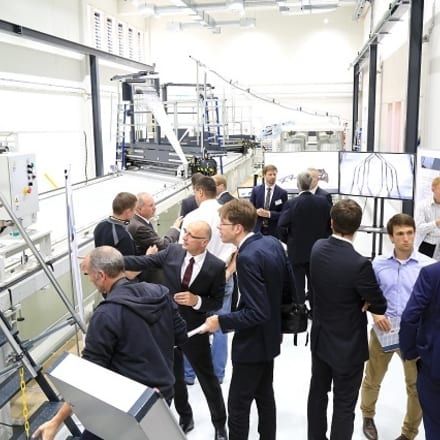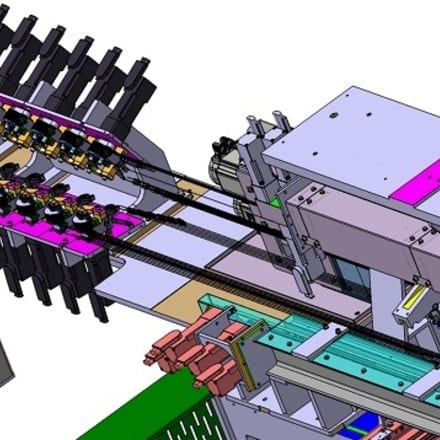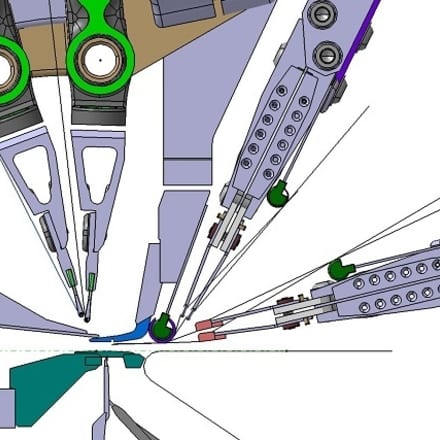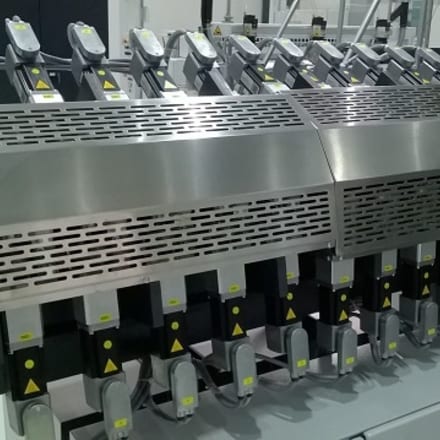KARL MAYER takes part in the Open Hybrid LabFactory initiative by supplying a modified multiaxial warp knitting machine
New multiaxial textiles for accurate force flow mapping
The need for personal mobility is, and will continue to be, a growth trend and a driver of progress. In order to be able to cope with the growing demand worldwide for cars, lightweight materials and new production techniques are needed. Projects for developing key technologies should be promoted and cooperation between experts should be supported.
One of the most recent initiatives, which is supported by public funding, is the setting-up of the Open Hybrid LabFactory in Wolfsburg. This research campus was officially opened on 22 September 2016. T
To the technical equipment and machinery of the new innovation centre belongs a multiaxial warp knitting machine supplied by KARL MAYER Technische Textilien (Technical Textiles).
Multiaxial textiles based on Nature
KARL MAYER Technische Textilien has equipped the Open Hybrid LabFactory with a multiaxial warp knitting machine (Fig. 1), and is further developing this machine to enable fibre-reinforced constructions to suit the direction of force to be mass-produced. The project that has been set up in order to do this is known as KonText. It is scheduled to run from 1 January 2015 to 31 December 2018 and is being carried out in cooperation with CETEX – Institut für Textil- und Verarbeitungsmaschinen gGmbH (Not-for-profit Institute of Textile and Processing Machines) and other project partners. The idea behind this project is to separate the load-bearing carbon fibres in a multiaxial textile made from glass fibres with the multiaxial warp knitting machine, and only bring them together at exposed sections, just as happens in Nature with the knotholes in trees.
This principle of using the right material in the right place reduces the weight considerably – for a car bonnet, this might be as much as 25% less than a similar, conventional component. The volume of carbon fibres, and consequently the costs, can also be reduced. Producing this type of car bonnet is roughly 30% cheaper than the method using conventional CFRPs. In addition to the car bonnet, the production of floor components using the differentiated, fibre-reinforced technology also offers other advantages, since the flat components can be shaped easily by compression moulding and, as non-visible components, they do not need to have a Class A surface.
Integration of electronic warp yarn patterning into the multiaxial warp knitting machine
The most important modification to the multiaxial warp knitting machine concerned the knitting elements. In addition to the two ground guide bars, a module had to be integrated for inserting the carbon tapes, whose shog paths would enable the construction to be worked to suit the specific characteristics of the relevant force insertion patterns. It also had to be possible to work interlaced patterns, such as “knotholes” (Fig. 2). To achieve this objective, engineers from KARL MAYER Technische Textilien took a leaf out of the book of their colleagues working in the lace machine sector. They got to grips with the string bar technology of lace raschel machines, and adapted the electronic patterning principle so that it could be used on a multiaxial warp knitting machine. Similar to the system of guide bars equipped with string bars, the machine was fitted with a warp yarn shogging module with two shogging units (Fig. 3). The shogging units are arranged opposite to each other to enable them to also work crossed-over lappings, and guide the carbon-fibre material via tape guides to the knitting point (Fig. 4). Up to 12 of these guide elements may be arranged in a block, and they may be moved together, individually or in specific groups. The individual motor drives used (Fig. 5) offer plenty of scope for designing the zones with the load-bearing carbon tapes: as far as the density is concerned, this can be done via the distance of the individual yarn guides from each other and, as far as the elongation, or lapping construction, is concerned, this can be done by the pattern-controlled movement of the shogging unit with two independent shog rows. In general, shog paths as large as the maximum working width of the machine are possible.
The carbon-fibre tapes are taken off from the packages in a controlled manner, and the active control system guarantees a uniform tape tension.
Future stages
This multiaxial warp knitting machine with the new warp yarn shogging module went into operation in the Open Hybrid LabFactory in the third quarter of this year. The multiaxial textiles subsequently produced are being used for research into the next stages of the production sequences. The resin treatment processes, in particular, have to be adapted to the new geometry of the textiles, in which the yarns are concentrated in selected areas. Further developments are also planned for the multiaxial warp knitting machine. The aim is to integrate a weft yarn shogging module by the third quarter of 2017.
Back to overview




